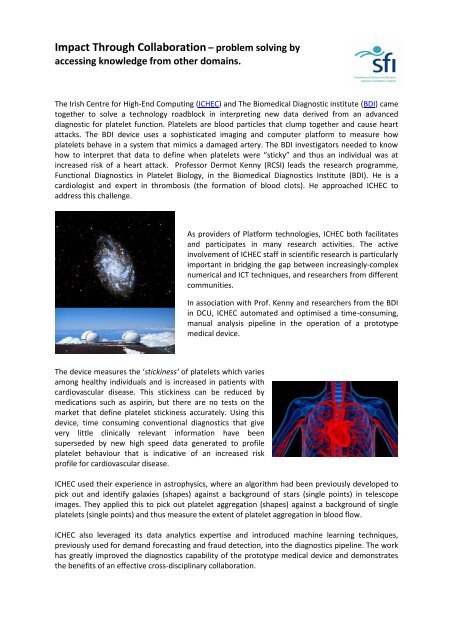Impact Through Collaboration– problem solving by
Impact Through Collaboration– problem solving by
Impact Through Collaboration– problem solving by
You also want an ePaper? Increase the reach of your titles
YUMPU automatically turns print PDFs into web optimized ePapers that Google loves.
<strong>Impact</strong> <strong>Through</strong> Collaboration – <strong>problem</strong> <strong>solving</strong> <strong>by</strong>accessing knowledge from other domains.The Irish Centre for High-End Computing (ICHEC) and The Biomedical Diagnostic institute (BDI) cametogether to solve a technology roadblock in interpreting new data derived from an advanceddiagnostic for platelet function. Platelets are blood particles that clump together and cause heartattacks. The BDI device uses a sophisticated imaging and computer platform to measure howplatelets behave in a system that mimics a damaged artery. The BDI investigators needed to knowhow to interpret that data to define when platelets were “sticky” and thus an individual was atincreased risk of a heart attack. Professor Dermot Kenny (RCSI) leads the research programme,Functional Diagnostics in Platelet Biology, in the Biomedical Diagnostics Institute (BDI). He is acardiologist and expert in thrombosis (the formation of blood clots). He approached ICHEC toaddress this challenge.As providers of Platform technologies, ICHEC both facilitatesand participates in many research activities. The activeinvolvement of ICHEC staff in scientific research is particularlyimportant in bridging the gap between increasingly-complexnumerical and ICT techniques, and researchers from differentcommunities.In association with Prof. Kenny and researchers from the BDIin DCU, ICHEC automated and optimised a time-consuming,manual analysis pipeline in the operation of a prototypemedical device.The device measures the ‘stickiness’ of platelets which variesamong healthy individuals and is increased in patients withcardiovascular disease. This stickiness can be reduced <strong>by</strong>medications such as aspirin, but there are no tests on themarket that define platelet stickiness accurately. Using thisdevice, time consuming conventional diagnostics that givevery little clinically relevant information have beensuperseded <strong>by</strong> new high speed data generated to profileplatelet behaviour that is indicative of an increased riskprofile for cardiovascular disease.ICHEC used their experience in astrophysics, where an algorithm had been previously developed topick out and identify galaxies (shapes) against a background of stars (single points) in telescopeimages. They applied this to pick out platelet aggregation (shapes) against a background of singleplatelets (single points) and thus measure the extent of platelet aggregation in blood flow.ICHEC also leveraged its data analytics expertise and introduced machine learning techniques,previously used for demand forecasting and fraud detection, into the diagnostics pipeline. The workhas greatly improved the diagnostics capability of the prototype medical device and demonstratesthe benefits of an effective cross-disciplinary collaboration.
TIPThe value to your work ofknowledge and expertise fromother fields can beconsiderable. You need to findthe right people and this caseshows the value oforganisations and centreswhich contain a wide range ofexperience and expertise intechnology solutions.TIP‘The language of clinicians, engineers,scientists, computer experts etc isfundamentally a different language.After two years working with ICHEC weare starting to understand theirlanguage and vice versa. If theselinguistic differences are not overcomethe probability of any translationalresearch being effective is very low. It isonly <strong>by</strong> working together on a researchproject that this occurs’ – Prof DermotKenny, RCSI.Apart from enhancing diagnostics capability, ICHEC also optimised and automated a labour-intensiveand error-prone computer analysis protocol as part of its collaboration. It developed a platform thatenables the device operator to easily upload the raw data acquired <strong>by</strong> the medical device and obtainthe key analytical results in a few minutes per experiment, rather than hours or days it tookpreviously in batches. Another advantage of this technology is it has enabled the prototype medicaldevice to be deployed at multiple physical locations <strong>by</strong> centralising the analysis on an ICHEC-hostedserver. This has ensured consistency and standardisation of the protocol, which has also assisted inthe calibration of equipment at different sites.The workflow optimisation and automation work has enabled the trial of the prototype medicaldevice on a much larger sample of donors/patients with greatly reduced turn-around time to results.The efficient, centralised analysis was a key factor in the roll-out of the device to a new site, theclinical research centre of the Royal College of Surgeons in Ireland. At present the device is beingused to test samples from a range of patients both with and at risk for cardiovascular disease. Thecollaborative research of BDI and ICHEC has made a giant stride in progressing a medical device froma laboratory prototype to its usage in near patient care and developing a novel clinically relevantdiagnostic device.IMPACT:The impacts from this research and collaboration are far reaching. Thedevelopment of the technology, borrowing ideas from fields such as astrophysicsand machine learning, to its application in the prevention of heart attacks andstrokes has clearly improved an existing device currently in use. Testing of thedevice is on-going but it has the potential to revolutionise this diagnostic in thehealth industry through radically faster turn-around time on patient results and itsnear patient care use.


